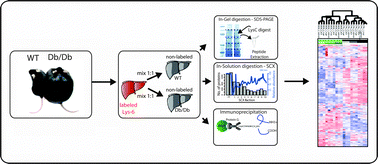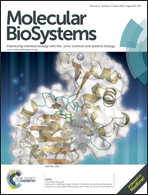Dissection of metabolic pathways in the Db/Db mouse model by integrative proteome and acetylome analysis†
Abstract
Insulin resistance is often associated with excessive caloric intake and metabolic syndrome (MS) favours the development of Diabetes Mellitus Type II (T2DM). T2DM is a chronic disease with severe long-term consequences, such as dyslipidemia, retinopathy, kidney failure, and cardiovascular diseases. Although studied extensively, several aspects of T2DM remain poorly understood. Liver is the leading organ in the maintenance of metabolic fitness serving as the first relay station for processing dietary information in a direct response to nutritional input and changes in insulin and other endocrine signals. Evidence from several murine models suggests a unique function of the liver in the development of MS and T2DM. Here, we utilised Db/Db mice to understand the impact of T2DM on the proteome of liver cells. Global analysis of the liver proteome using a SILAC approach identified 407 significantly regulated proteins under diabetic conditions out of 8500 identified liver proteins. Furthermore, we mapped 1604 different acetylation sites in liver proteins. After normalization of the protein level, we identified 34 regulated acetyl lysine residues on 21 individual proteins, which were significantly altered in Db/Db compared to wild-type livers. We reason that the dataset provides a versatile resource for functional studies aiming to understand consequences of changes in protein abundances and acetylation in livers of diabetic animals.


 Please wait while we load your content...
Please wait while we load your content...